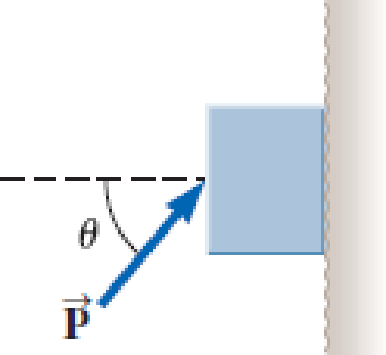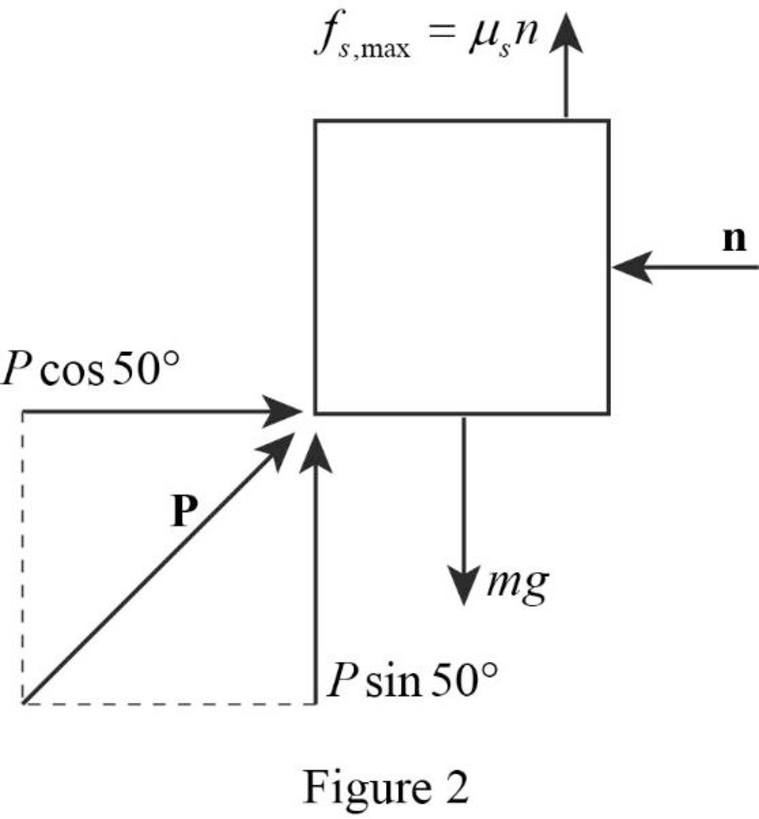
Concept explainers
A block of mass 3.00 kg is pushed up against a wall by a force

Figure P5.12
(a)
The possible value for the magnitude of force
Answer to Problem 12P
The possible value for the magnitude of force
Explanation of Solution
Assume that, the block is moving in upward direction to get maximum possible value of

Assume that, the net force along
Here,
From the free body diagram, write the expression for net force along
Here,
Write the expression for frictional force for maximum
Here,
Solve equation (II) for
Use equation (IV) in (III).
Assume that, the net force along
Here,
From the free body diagram, write the expression for net force along
Solve equation (VII) for
Assume that, the block is moving in downward motion to get minimum possible value of

Assume that, the net force along
From the free body diagram, write the expression for net force along
Solve equation (VII) for
Conclusion:
Substitute,
Substitute,
Substitute,
Therefore, The possible value for the magnitude of force
(b)
The result if
Answer to Problem 12P
When
Explanation of Solution
Maximum value of force
Conclusion:
Therefore,
(c)
The possible value for the magnitude of force
Answer to Problem 12P
The possible value for the magnitude of force
Explanation of Solution
Rewrite the equation (V) for angle
Rewrite the equation (VIII) for angle
Rewrite the equation (X) for angle
Conclusion:
Substitute,
Substitute,
It is not possible to be negative, so however large or small it is, it cannot produce upward motion
Substitute,
Therefore, The possible value for the magnitude of force
Want to see more full solutions like this?
Chapter 5 Solutions
Principles of Physics: A Calculus-Based Text
- A desperate hiker has to think fast to help his friend who has fallen below him. Quickly, he ties m, a rope to a rock of mass m, = 3.90 x 10? kg and makes his way over the ledge (see the figure). If the coefficient of static friction between the rock and the ground is µs = 0.283, and the mass of the hiker is m, = 70.1 kg, what is the maximum mass of the friend m; that the rock can hold so the hikers can then make their way up over the ledge? Assume the rope is parallel to the ground and the point where the rope passes over the ledge is frictionless. kg IIarrow_forwardA railroad car which has a mass 9216 kg is constrained to move along a horizontal track under the action of a wind blowing in the direction of the track. The frictional resistance to the car motion is 1/200 of its weight. The force exerted by wind is P=kSu2, where S is the area of the backside of the railroad car, equals to 6 m2, and u is the velocity of the wind relative to car, k=0.12. The absolute velocity of the wind is w=12 m/s. The initial velocity of the railroad car is 0. Determine:a) the maximum velocity vmax of the railroad car;b) the time T taken to reach this velocity;c) the distance x, travelled by the railroad car before reaching a velocity of 3 m/sarrow_forwardA 1.80x10^4 kg semi-trailer truck drives up a 200 m hill [θ = 30 degrees above horizontal], at a constant speed of 25.0 m/s. The force of friction is 6.00x10^2 N. Write an equation to isolate and solve for P.arrow_forward
- Your friend asks for help moving a box across the apartment floor and tells you that the box weighs 422 N. Your friend also informs you the box, currently motionless, has a coefficient of static friction (us=0.42) and a coefficient of kinetic friction (u=0.31) between it and the floor. You apply a horizontal force of 208 N on the box. Calculate the magnitude of the frictional force, f, acting on the box while you apply that force. Take the acceleration of gravity to be 9.81 m/s². f = O Search N 7:59 PM 11/29/2022arrow_forwardA force in the +x-direction with magnitude F(x) = 18.0 N - (0.530 N/m)x is applied to a 8.30 kg box that is sitting on the horizontal, frictionless surface of a frozen lake. F(x) is the only horizontal force on the box.arrow_forwardA force in the +x+x-direction with magnitude F(x)=18.0N−(0.530N/m)xF(x)=18.0N−(0.530N/m)x is applied to a 7.10 kgkg box that is sitting on the horizontal, frictionless surface of a frozen lake. F(x)F(x) is the only horizontal force on the box. 1. If the box is initially at rest at x=0x=0, what is its speed after it has traveled 14.0 mm ? Express your answer to three significant figures and include the appropriate units.arrow_forward
- A box of books with mass 55 kg rests on the level floor of the campus bookstore. The floor is freshly waxed and has negligible friction. A bookstore worker applies a constant horizontal force with magnitude 25 N to the box. What is the magnitude of the acceleration of the box?arrow_forward42. A block initially at rest slides down a ramp of length L that makes an angle of θ with the horizontal. (a) Derive an equation that predicts the time required for the block to reach the bottom of the ramp in terms of L, θ, g, and μ, the coefficient of friction. (b) This derived equation has no real solutions for angles θ ≤ tan–1 (μ). Show algebraically this is the case and explain the physical significance of this – i.e. what does this mean about an actual block on an actual ramp with actual friction?arrow_forwardA 5.6kg box is hang on both ends making an angle of 27° on one end and 58° on another, both from the horizontal line. If the string from 27° generates a tension of 34.2N, what is the y-component of the given tension? O 30.47 N O 51.25 N O 30.74 N O No answer O 15.52 Narrow_forward
- A box is dropped on a level conveyor belt that is moving at 4.5 m/s in the +x direction in a shipping facility. The box/belt friction coefficient is 0.15. For what duration will the box slide on the belt? In which direction does the friction force act on the box? How far will the box have moved horizontally by the time it stops sliding along the belt?arrow_forwardYou and your friend Peter are putting new shingles on a roof pitched at 25°. You’re sitting at the very top of the roof when Peter, who is on the end of the roof, 5.2 m away, asks you for the box of nails. Rather than carry 2.2 kg box of nails down to Peter, you decide to give the box a push and have it slide down to him. If the coefficient of kinetic friction between the box and the roof is 0.55, with what speed should you push the box to have it gently come to rest right at the edge of the roof?arrow_forwardProblem Like friction, drag force opposes the motion of a particle in a fluid; however, drag force depends on the particle's velocity. Find the expression for the particle's velocity v(x) as a function of position at any point x in a fluid whose drag force is expressed as Fdrag = kmv where k is a constant, m is the mass of the particle and v is its velocity. Assume that the particle is constrained to move in the x-axis only with an initial velocity vo- Solution: The net force along the x-axis is: ΣF-F = m then: mv = m Since acceleration is the first time derivative of velocity a = dv/dt, mv = m We can eliminate time dt by expressing, the velocity on the left side of the equation as v = dx/dt. Manipulating the variables and simplifying, we arrive at the following expression = -k "Isolating" the infinitesimal velocity dx and integrating with respect to dx, we arrive at the following: = vo - which shows that velocity decreases in a linear manner.arrow_forward
 College PhysicsPhysicsISBN:9781305952300Author:Raymond A. Serway, Chris VuillePublisher:Cengage Learning
College PhysicsPhysicsISBN:9781305952300Author:Raymond A. Serway, Chris VuillePublisher:Cengage Learning University Physics (14th Edition)PhysicsISBN:9780133969290Author:Hugh D. Young, Roger A. FreedmanPublisher:PEARSON
University Physics (14th Edition)PhysicsISBN:9780133969290Author:Hugh D. Young, Roger A. FreedmanPublisher:PEARSON Introduction To Quantum MechanicsPhysicsISBN:9781107189638Author:Griffiths, David J., Schroeter, Darrell F.Publisher:Cambridge University Press
Introduction To Quantum MechanicsPhysicsISBN:9781107189638Author:Griffiths, David J., Schroeter, Darrell F.Publisher:Cambridge University Press Physics for Scientists and EngineersPhysicsISBN:9781337553278Author:Raymond A. Serway, John W. JewettPublisher:Cengage Learning
Physics for Scientists and EngineersPhysicsISBN:9781337553278Author:Raymond A. Serway, John W. JewettPublisher:Cengage Learning Lecture- Tutorials for Introductory AstronomyPhysicsISBN:9780321820464Author:Edward E. Prather, Tim P. Slater, Jeff P. Adams, Gina BrissendenPublisher:Addison-Wesley
Lecture- Tutorials for Introductory AstronomyPhysicsISBN:9780321820464Author:Edward E. Prather, Tim P. Slater, Jeff P. Adams, Gina BrissendenPublisher:Addison-Wesley College Physics: A Strategic Approach (4th Editio...PhysicsISBN:9780134609034Author:Randall D. Knight (Professor Emeritus), Brian Jones, Stuart FieldPublisher:PEARSON
College Physics: A Strategic Approach (4th Editio...PhysicsISBN:9780134609034Author:Randall D. Knight (Professor Emeritus), Brian Jones, Stuart FieldPublisher:PEARSON





